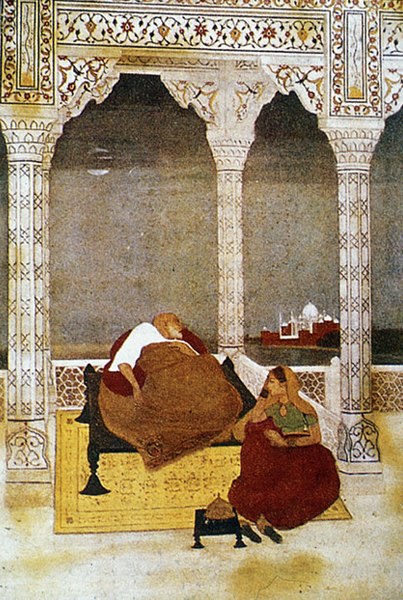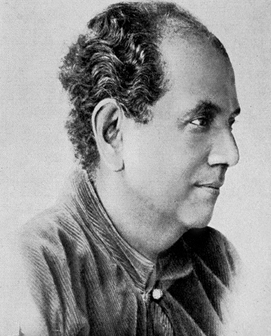Abanindranath Tagore
Abanindranath Tagore (7 August 1871 - 5 December 1951) was the principal artist and creator of 'Indian Society of Oriental Art' and the first major exponent of swadeshi values in Indian art, thereby founding the influential Bengal school of art,which led to the development of modern Indian painting He was also a noted writer, particularly for children. Popularly known as 'Aban Thakur', his books Rajkahini, Budo Angla, Nalak, and Ksheerer Putul are landmarks in Bengali language children's literature.
Tagore sought to modernize Moghul and Rajput styles in order to counter the influence of Western models of art, as taught in Art Schools under the British Raj and developed the Indian style of painting, later known as Bengal school of art. Such was the success of Tagore's work that it was eventually accepted and promoted as a national Indian style within British art institutions under the epithet of Indian Society of Oriental Art.
Personal life and background
Abanindranath Tagore was born in Jorasanko, Calcutta, British India to Gunendranath Tagore. His grandfather was Girindranath Tagore,the second son of "Prince" Dwarkanath Tagore. He is a member of the distinguished Tagore family, and a nephew of the poet Rabindranath Tagore. His grandfather and his elder brother Gaganendranath Tagore were also artists.Tagore learned art when studying at Sanskrit College, Kolkata in the 1880s. Around the age of twenty years of age, in 1890, Abanindranath attended the Calcutta School of Art where he learnt to use pastels from O. Ghilardi, and oil painting from Charles Palmer, European painters who taught in that institution.
In 1889 he married Suhasini Devi, daughter of Bhujagendra Bhusan Chatterjee, a descendant of Prasanna Coomar Tagore. At this time he left the Sanskrit College after nine years of study and studied English as a special student at St. Xavier's College, which he attended for about a year and a half.
He had a sister Sunayani Devi.
Painting career
Early days
 In the early 1890s several illustrations were published in Sadhana
magazine, and in Chitrangada, and other works by Rabindranath Tagore. He
also illustrated his own books. He is nephew of Rabindranath Tagore.
About the year 1897 he took lessons from the Vice-Principal of the Government School of Art, studying in the traditional European academic
manner, learning the full range of techniques, but with a particular
interest in watercolour. At this time he began to come under the
influence of Mughal art, making a number of works based on the life of Krishna in a Mughal-influenced style. After meeting E.B. Havell,
Tagore worked with him to revitalise and redefine art teaching at the
Calcutta School of art, a project also supported by his brother
Gaganendranath, who set up the Indian Society of Oriental Art.
In the early 1890s several illustrations were published in Sadhana
magazine, and in Chitrangada, and other works by Rabindranath Tagore. He
also illustrated his own books. He is nephew of Rabindranath Tagore.
About the year 1897 he took lessons from the Vice-Principal of the Government School of Art, studying in the traditional European academic
manner, learning the full range of techniques, but with a particular
interest in watercolour. At this time he began to come under the
influence of Mughal art, making a number of works based on the life of Krishna in a Mughal-influenced style. After meeting E.B. Havell,
Tagore worked with him to revitalise and redefine art teaching at the
Calcutta School of art, a project also supported by his brother
Gaganendranath, who set up the Indian Society of Oriental Art.Later career
Abanindranath Tagore believed that Western art was "materialistic" in character, and that India needed to return to its own traditions in order to recover spiritual values. Despite its Indocentric nationalism, this view was already commonplace within British art of the time, stemming from the ideas of the Pre-Raphaelites. Tagore's work also shows the influence of Whistler's Aestheticism. Partly for this reason many British arts administrators were sympathetic to such ideas, especially as Hindu philosophy was becoming increasingly influential in the West following the spread of the Theosophy movement. Tagore believed that Indian traditions could be adapted to express these new values, and to promote a progressive Indian national culture.With the success of Tagore's ideas, he came into contact with other Asian artists whose work was comparable to his own. In his later work, he began to incorporate elements of Chinese and Japanese calligraphic traditions into his art, seeking to construct a model for a modern pan-Asian artistic tradition which would merge the common aspects of Eastern spiritual and artistic culture.[5]
 His close students included Nandalal Bose, Kalipada Ghoshal, Kshitindranath Majumdar, Surendranath Ganguly, Asit Kumar Haldar, Sarada Ukil, Samarendranath Gupta, Mukul Dey, K. Venkatappa and Ranada Ukil.
His close students included Nandalal Bose, Kalipada Ghoshal, Kshitindranath Majumdar, Surendranath Ganguly, Asit Kumar Haldar, Sarada Ukil, Samarendranath Gupta, Mukul Dey, K. Venkatappa and Ranada Ukil.For Abanindranath, the house he grew up in (5 Dwarakanath Tagore Lane) and its companion house (6 Dwarakanath Tagore Lane) connected two cultural worlds -- 'white town' (where the British colonizers lived) and 'black town' (where the natives lived). According to architectural historian Swati Chattopadhay, Abanindranath "used the Bengali meaning of the word, Jorasanko -- 'double bridge' to develop this idea in the form of a mythical map of the city. The map is, indeed, not of Calcutta, but an imaginary city, Halisahar, and is the central guide in a children's story Putur Boi (Putu's Book). The nineteenth-century place names of Calcutta, however, appear on this map, thus suggesting we read this imaginary city with the colonial city as a frame of reference. The map uses the structure of a board game—golokdham—and shows a city divided along a main artery; on one side a lion-gate leads to the Lal-Dighi in the middle of which is the 'white island.'[6]
 Abanindranath maintained throughout his life a long friendship with
the London-based artist, author, and eventual president of London's Royal College of Art William Rothenstein. Arriving in the autumn of 1910, Rothenstein spent almost a year surveying India's cultural and religious sites, including the ancient Buddhist caves of Ajanta; the Jain carvings of Gwalior; and the Hindu panoply of Benares. He ended up in Calcutta, where he drew and painted with Abanindranath and his students, attempting to absorb elements of Bengal School style into his own practice.[7]
Abanindranath maintained throughout his life a long friendship with
the London-based artist, author, and eventual president of London's Royal College of Art William Rothenstein. Arriving in the autumn of 1910, Rothenstein spent almost a year surveying India's cultural and religious sites, including the ancient Buddhist caves of Ajanta; the Jain carvings of Gwalior; and the Hindu panoply of Benares. He ended up in Calcutta, where he drew and painted with Abanindranath and his students, attempting to absorb elements of Bengal School style into his own practice.[7]However limited Rothenstein's experiments with the styles of early Modernist Indian painting were, the friendship between him and Abanindranath ushered in a crucial cultural event. This was Rabindranath Tagore's soujourn at Rothenstein's London home, which led to the publication of the English language version of Gitanjali and the subsequent award to Rabindranath in 1913 of the Nobel Prize for Literature.
The publication of Rabindranath Tagore's Gitanjali in English brought the Tagore family international renown, which helped to make Abanindranath's artistic projects better known in the west.
List of paintings
A list of paintings by Abanindranath Tagore is as follows:[8]
|
|


No comments:
Post a Comment